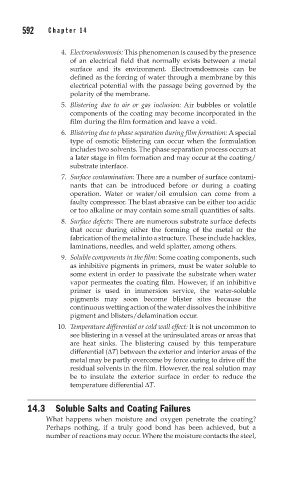Page 629 - Corrosion Engineering Principles and Practice
P. 629
592 C h a p t e r 1 4 P r o t e c t i v e C o a t i n g s 593
4. Electroendosmosis: This phenomenon is caused by the presence
of an electrical field that normally exists between a metal
surface and its environment. Electroendosmosis can be
defined as the forcing of water through a membrane by this
electrical potential with the passage being governed by the
polarity of the membrane.
5. Blistering due to air or gas inclusion: Air bubbles or volatile
components of the coating may become incorporated in the
film during the film formation and leave a void.
6. Blistering due to phase separation during film formation: A special
type of osmotic blistering can occur when the formulation
includes two solvents. The phase separation process occurs at
a later stage in film formation and may occur at the coating/
substrate interface.
7. Surface contamination: There are a number of surface contami-
nants that can be introduced before or during a coating
operation. Water or water/oil emulsion can come from a
faulty compressor. The blast abrasive can be either too acidic
or too alkaline or may contain some small quantities of salts.
8. Surface defects: There are numerous substrate surface defects
that occur during either the forming of the metal or the
fabrication of the metal into a structure. These include hackles,
laminations, needles, and weld splatter, among others.
9. Soluble components in the film: Some coating components, such
as inhibitive pigments in primers, must be water soluble to
some extent in order to passivate the substrate when water
vapor permeates the coating film. However, if an inhibitive
primer is used in immersion service, the water-soluble
pigments may soon become blister sites because the
continuous wetting action of the water dissolves the inhibitive
pigment and blisters/delamination occur.
10. Temperature differential or cold wall effect: It is not uncommon to
see blistering in a vessel at the uninsulated areas or areas that
are heat sinks. The blistering caused by this temperature
differential (∆T) between the exterior and interior areas of the
metal may be partly overcome by force curing to drive off the
residual solvents in the film. However, the real solution may
be to insulate the exterior surface in order to reduce the
temperature differential ∆T.
14.3 Soluble Salts and Coating Failures
What happens when moisture and oxygen penetrate the coating?
Perhaps nothing, if a truly good bond has been achieved, but a
number of reactions may occur. Where the moisture contacts the steel,

